

Buyer contact to grand piano price click here!
NAVIGATION : Concert Grad piano - Petrof Grand Piano Forte - Petrof Opus 1631 - Concert grand piano build year 1882 - Antique piano sale - Custom grand piano builder - Royal Court piano supplier - Piano Original Ivory keyboard - Grand Piano price
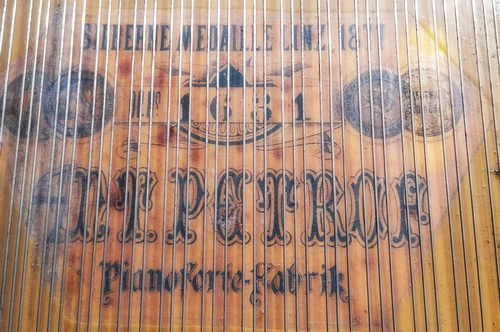 Petrof Opus 1631 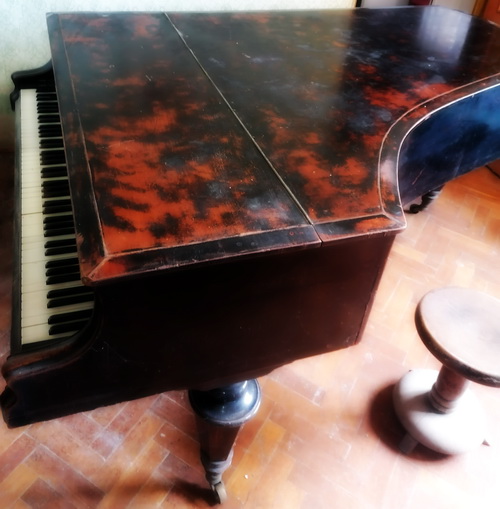 |
Petrof Grand Rare Piano Forte Opus 1631 year 1882Antique piano for sale Price start from: 40000 euro not include shipping and handling fee! Bidding step 5000 euro! Location in Hungary OP. 1631 with original ivory keyboard How much new Antonín Petrof grand Piano cost? About 85000 to 244000 US dollar! https://pianopricepoint.com/petrof-piano/ From: 1800-luku (19th century) 1801.01.01. – 1900.12.31. Info from marketing(at)petrof.com : Thank you for your interest in your instrument's history. Your OPUS no. 1631 matches: Year of production: start 1881 ready 1882 Production site: Hradec Králové, Czech in Europe. Made for: Austrian Hungarian Royal Court order! Osztrák Magyar Királyi udvar rendelése! Before my Family buy for me the concert garnd piano forte about year 1977, it was a Hungarian Count family the who ordered it. It had no find any ordinary other average serial number (like 123456), because it was special order! But this Opn. 1631 was recognise in Petrof registry! Just an OPUS number 1631 (mean work number) Made for: Austrian Hungarian Royal Court order! Normal piano serial numbers not Royal Court are 5 or 6 digits! DATE OF MANUFACTURE SERIAL NUMBER are the next: 1950-67280 1975-211900 1982-340000 1910-8450 1960-87200 1976-233700 1985-355000 1920-10500 1965-103700 1978-302500 1987-380000 1930-46500 1970-146900 1980-314242 1988-395660 1940-58000 1974-208900 1981-325000 1994-440000 and 2008 - Present 617610+ Original Ivory keyboard. The black keys are usually made of ebony wood. First class Ivory covered the top surface of the white keys are whte, has not yellow color at all! Probably the same wood material used for the soundboard is used for the keys, such as Sitka spruce or Japanese spruce, which are virtually free from warpage. Black paited mahogany case. During more than 120 years of polishing, the black color fades, and the worn, ebony color is visible. Specially above the surface of the grand concert piano. |
Concert Grad piano Company founder Antonin Petrof custom grand piano builder lived 1839–1915 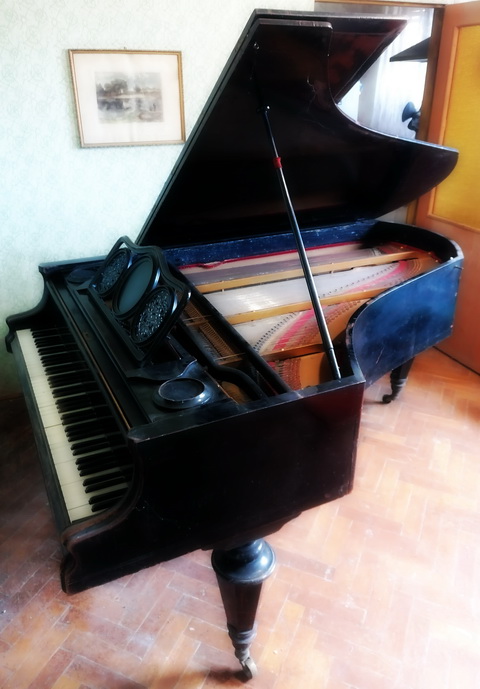 Petrof opus 1631 grand piano Forte 1882 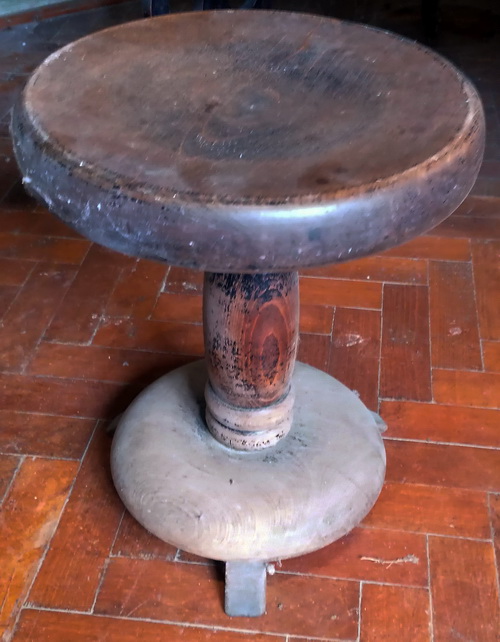 Year1882 Petrof grand piano origin stool |
A. Petrof Company is a Czech piano manufacturer based in Hradec KrálovéIn north-eastern Bohemia and the largest manufacturer of acoustic grand and upright pianos in Europe. The instruments are sold on all five continents in 65 countries worldwide. Since 1864, when Antonín Petrof built his first grand piano, over 630,000 instruments have been manufactured under the Petrof name, as well as many other names within the PETROF brand family. Petrof instruments are famous among musicians for their extraordinarily round, warm-romantic and yet extremely modulation-capable tone. Of course, production has changed in many ways over a century and a half, but precise craftsmanship, the most careful selection of materials and the incomparable, romantic tone have remained. Countless famous artists as well as well-known personalities have fallen in love with the sound of Petrof instruments, which is why the representatives of the fifth generation of the Petrof family carry on their family tradition with great pride. The company was founded in 1864 by the piano maker Antonín Petrof (German Anton Petrof) in Hradec Králové. He had previously trained in Vienna with various well-known piano manufacturers such as Heitzmann, Friedrich Ehrbar and Schweighofer. Success came over the years and he was able to rise to become a major manufacturer. Among the customers were the imperial court. In 1899 Petrof received the privilege of a k.u.k. Purveyors to the court and the title of a secret court councillor. The sons later received both titles. In 1908 the company was transformed into a general partnership, Petrof's wife Marie became an authorized signatory and their sons Jan, Antonín and Vladimír became part of the company. Antonín and Marie Petrof died in 1915, the management was taken over by the youngest son Vladimír Petrof. From 1924 pianos were exported to America, Asia and Australia. In 1928, Petrof and Steinway opened a branch on Wigmore Street in London. The third generation of the family business began with the entry of Dimitrij, Eduard and Eugen Petrof. The piano manufacturer Petrof was awarded the Grand Prix during the 1935 World Exhibition in Brussels. At that time, 400 workers were employed in the company. In 1948 the manufacturer Petrof was nationalized, between 1991 and 1998 it was reprivatized. Petrof, which has been run by two sisters of the fifth generation of the Petrof family since 2004, is currently one of the largest piano manufacturers in Europe in terms of volume with up to 5,000 upright and 900 grand pianos per year. Since the beginning of the 21st century, Petrof has also been trying to innovate in piano construction. For example, the company developed a device that uses adjustable magnets to adjust the playing weight of the grand piano keys and adjust it according to the preferences of a pianist. In 1932 Petrof acquired the license to produce the electro-acoustic piano Neo-Bechstein, which was marketed as Neo-Petrof. Instruments from other brands are also manufactured in the Petrof manufactories. In the branch factory in Jiříkov (German Georgswalde), prefabricated Weinbach pianos are finally assembled in China. A factory of the August Förster company, which has its main plant in Löbau in Saxony, existed there until the Second World War. https://de.wikipedia.org/wiki/Petrof |
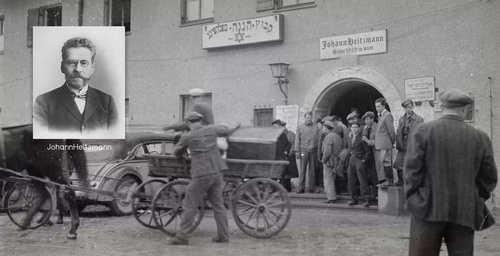 Heitzmann
& Sohn in Wien Factory Heitzmann
& Sohn in Wien Factory |
Rare piano J. Heitzmann & Sohn in Wien - 19th century Austrian Hungarian Royal Court supplierRare half-tail piano J. Heitzmann & Sohn in Wien Austrian Hungarian Royal Court supplier (historic Viennese producer since 1839). Great piece for collectors of both antiques and musical. About John Heitzmann * ?, † ?. Founded a piano factory in Vienna in 1839, which was based in Wieden (Vienna IV) from 1845. In 1847/48 the company name was changed to Heitzmann & Marschik, from 1867 to Heitzmann & Sohn. Company was and 1898. From 1871 Johann H. & Sohn Company Due to missing biographical data in many cases, the piano builders Ferdinand (* ?, † ?) and Josef (* ?, † July 7, 1896) cannot currently be clearly assigned to the family tree of the H. family; F.H. is 1884–87, Jos. H. 1865-77 mentioned as a piano maker, whereby Jos. H. was registered as a shareholder of the company H. & Sohn. Ludwig H. (* ?, † ?) was also a partner in the H. & Sohn company at least from 1871 to 1878. Otto H. (* ?, † ?) took over the company Johann H. & Sohn from Ludwig H. Antonin Petrof learn here is a significant producer of acoustic grand and upright pianos in Europe. Antonín P. made in company Czekh It trades in 5 continents and exports to over 65 countries the world over. Since 1864, when Antonín Petrof built his first piano. Later also Petrof comming the Austrian Hungarian Royal Court supplier! Following foot step Her Teacher Heitzmann. |
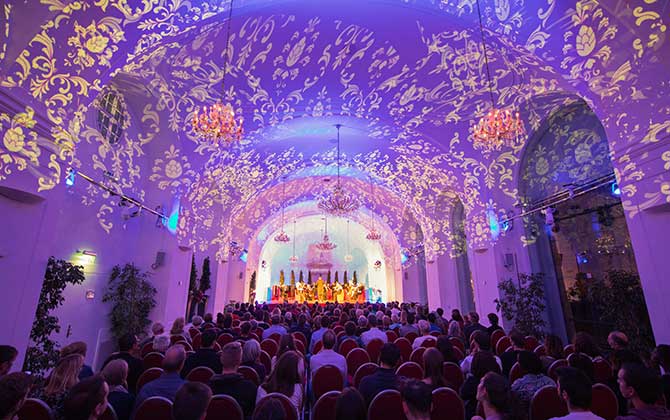  |
Famous Grand piano Forte Builders;Austrian piano makers, only Ehrbar (until 1980) and Bösendorfer survived the economic crisis of the 1920s and 1930s. Heitzmann & Sohn Those pianoforte factories started high quality and precision work quickly led to success. The unusual stability of the materials used and the high resilience of the instruments met the highest demands. Today the competition is enormous, but in the 19th century the company competed with the pianoforte manufacturer of the Saxon court Julius Blüthner (founded 1853) in Leipzig and with Bösendorfer (founded 1828) and Heitzmann & Sohn (founded 1839) in Vienna. However, each has its own mechanics and thus its special timbre. The amateur pianist Toni Wille only plays List and Chopin on the Bechstein rarity (from 1861). On the other Bechstein piano (from 1873), however, the composers of the Romantic era, such as Schuhmann and Brahms, on the Viennese fortepiano by Heitzmann & Sohn Beethoven and Schubert and on the Blüthner grand piano Mozart and Bach, as he explained to me. The pieces of music sound wonderful on the historical pianos, different than today, which is not only due to the faster playing tempo of today, but also to the change in mechanics. In the last 250 years, key pressure has increased from 30 to 60 grams and string tension from 5,000 to 25,000 kilograms. In Mozart's time, for example, one played a whole tone lower. The situation in piano construction has also changed. The demand for concert grand pianos has decreased. Space-saving pianos and last but not least cheap e-pianos or keyboards (usually have less than 88 keys) have pushed the good old grand pianos out of private homes. Of the well-known, old Austrian piano makers, only Ehrbar (until 1980) and Bösendorfer survived the economic crisis of the 1920s and 1930s. Heitzmann also had to close. Then Antonin Petrof come the Austrian Hungarian Royal Court supplier! |
NAVIGATION : Concert Grad piano - Petrof Grand Piano Forte - Petrof Opus 1631 - Concert grand piano build year 1882 - Antique piano sale - Custom grand piano builder - Royal Court piano supplier - Piano Original Ivory keyboard - Grand Piano price
Copyright Antique sale concert grand piano and furniture 19th century